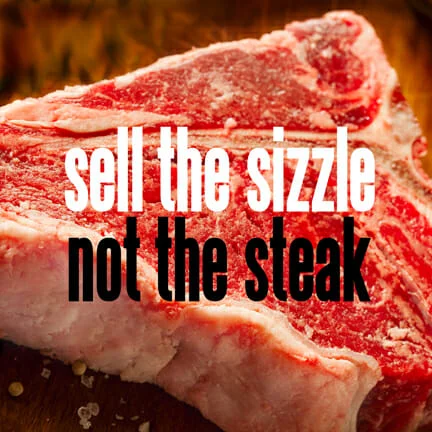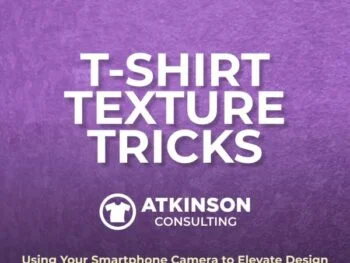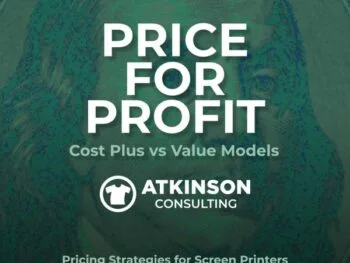
One of the age-old advertising mantras as been “Don’t sell the steak, sell the sizzle.” You’ve heard that before, right? That phrase is so intriguing I looked up who coined the term. The answer is: Elmer Wheeler, and he was one of the pioneers of persuasion in marketing. (More about his thinking at the end of this article.)
For a good number of decorating apparel shops, their marketing revolves around conversations about price. They are selling the steak and forgetting about the sizzle.
“Fast! Free Shipping! Best Prices!”
“50% Off! No Minimums.”
“Order now for discount.”
“We’ll beat any price.”
“Cheapest in town.”
Here’s the problem. If you are competing on price, you are ultimately going to lose because there will always be some other company that will do it for less. There’s only one way to go and that’s down. It is a game where everyone drops their pants.
So instead of basing your marketing on how much money you are ultimately willing to lose to get the customer, why not reposition your shop as one that is solving a problem for a customer instead?
Sell the problem you solve, not your product.
Think about your customers for a minute. What is their number one headache?
Maybe it is time sensitive, such as the order has to be there by Friday. Maybe it is quality driven, such as the art has to match Pantone colors exactly for a brand. Maybe it is creative minded such as using fantastic art will sell more shirts at retail. Maybe it is fulfillment oriented, as your company is the middleman in the deal for a salesperson or promotional item firm. Maybe it is technically oriented, as what you do is difficult for most other decorators. Maybe it’s the that they need some hand-holding such as you offer years of expert guidance. Maybe they just want one shirt. Maybe they need a hundred thousand shirts.
This is the sizzle.
You need to define the pain point you are solving for the customer. This is what you are illustrating non-stop in your marketing. This is what customers will be willing to pay you more for as you are solving their biggest challenge; that’s the benefit you need to yell from the rooftops. Your goal is to make it easy for them to make this connection. That’s their NEED.
Here’s how you do it:
First do your market research and find out how you can reach not only your current set of customers, but the restless horde of others that need your elite problem solving services. They are out there, believe me.
We’ll call this group your “Audience”. This is who you are thinking about when you craft a blog article, post something on Instagram or Snapchat, share something on Twitter or LinkedIn, or post on your Facebook page. Your mission is all about catering to selling the sizzle and nothing else.
You do this by engaging your audience. Constantly.
What makes you different than any of the other shops that can print or embroider a shirt? We all use basically the same tools. Solving the problems for your audience makes you the champion. When you make it easy for a customer to solve their problem, you become the “go-to” for everything. People will buy from companies that they know will make it easier for them and who they trust.
Illustrate what makes you special. Use photos or better yet, videos of your shop in action. Make it easy for the buyer to connect the dots and understand that you are their new best friend. Why? Your shop is going to make it easy for them to solve their challenge. Isn’t that what we want when we buy stuff?
Think about your own buying habits. Why do you use a particular website, shop at the corner store, wear that brand of clothes, or fund that one charity? You can learn a lot just from studying why you make your own particular purchasing decisions. Want to multiply that learning? Ask your customers what’s important to them.
What is the sizzle on the steak in your shop ? That’s the question you need to answer.
Then, start broadcasting how great that steak will taste to the hungry masses. They are ready to bite.
Just ring the dinner bell.
In his book, “Tested Sentences That Sell” Wheeler came up with five “Wheelerpoints”. These were simple phrases to think about when coming up with great marketing ideas. Read these below and ponder how you can use them in your shop:
“Don’t sell the steak, sell the sizzle.” – Illustrate your benefits. What problems are you solving for the customer? Write these down and develop your marketing ideas around them.
“Don’t write – telegraph!” – Back in 1937, telegraphing was charged by the word so choices counted. These days with social media, our attention spans are limited and crowded with other noise. Be very choosy in how you write and approach your marketing. “Your first ten words are more important than your next ten thousand.” Make them count.
“Don’t ask if – ask which.” – Always give your customer a choice between something and something…but never between something and nothing. For example, one of Wheeler’s clients was Abraham and Straus, a soda fountain chain. He championed a better way for the stores to sell more eggs. Instead of stating “Would you like an egg with that?”, Wheeler suggested having the clerks ask, “One egg or two?” while holding up and egg in each hand. This new suggestion increased egg orders by 70%. Soda fountain chains are long gone, but this premise still holds true today. What are your eggs?
“Say it with flowers.” – It’s not enough to just say “I Love You”. You have to prove it to the customer. Back up your marketing thought with proof. This is where a great photo or video can pay off tremendously. Demonstrate that your idea works. Show your love and affection with a figurative dozen roses.
“Watch your bark!” – Wheeler was a huge dog lover, and invented this phrase as a reminder to keep the marketing copy friendly and engaging. You can tell exactly what a dog feels by observing the way they wag their tail and the pitch and tone of their bark. When you push out your marketing, remember it isn’t always what you say but also how you say it. Cater to your audience. Are they wagging their tail at the tone of your bark? Are you even watching for this?



